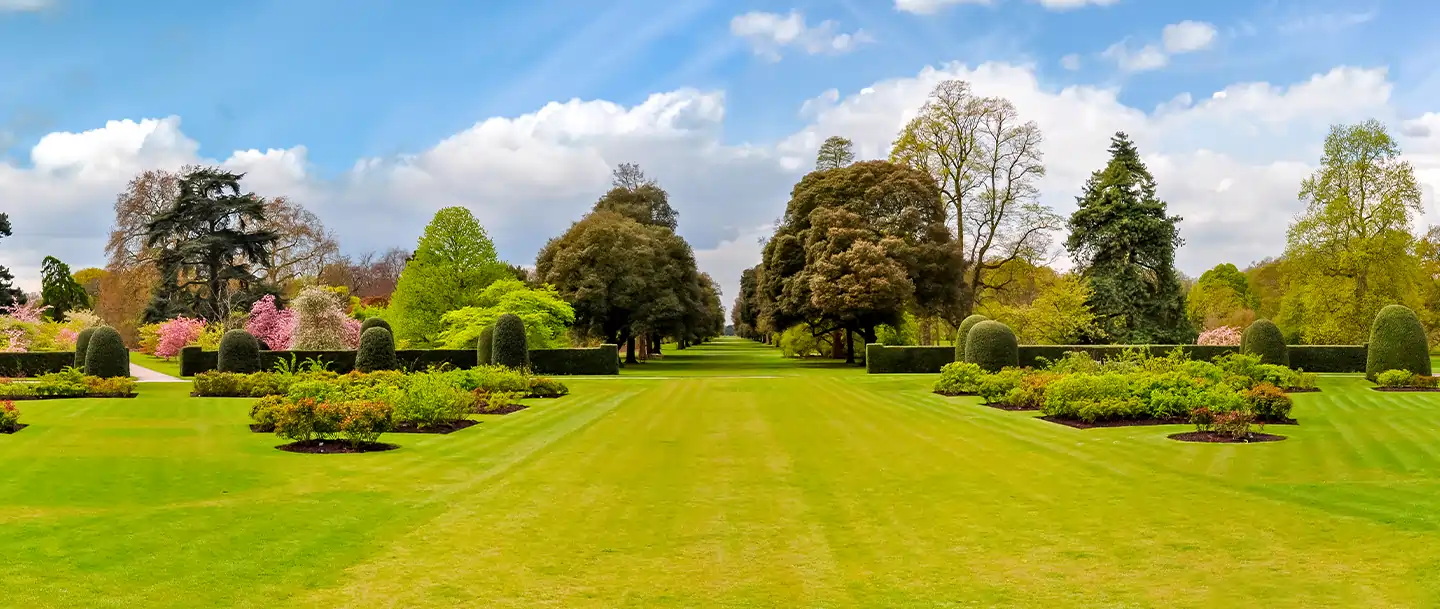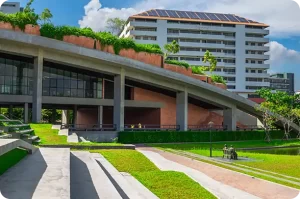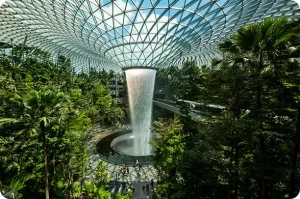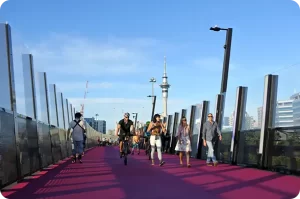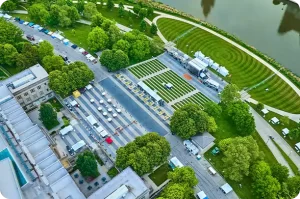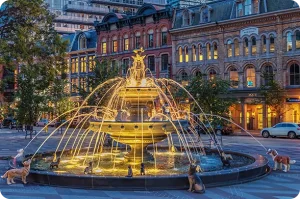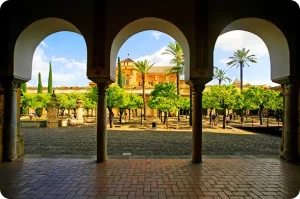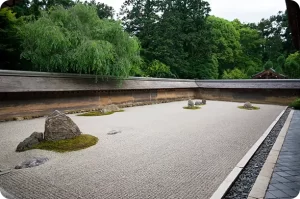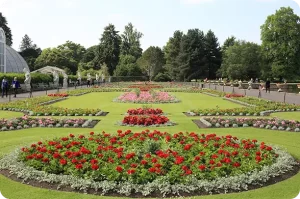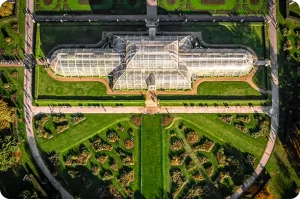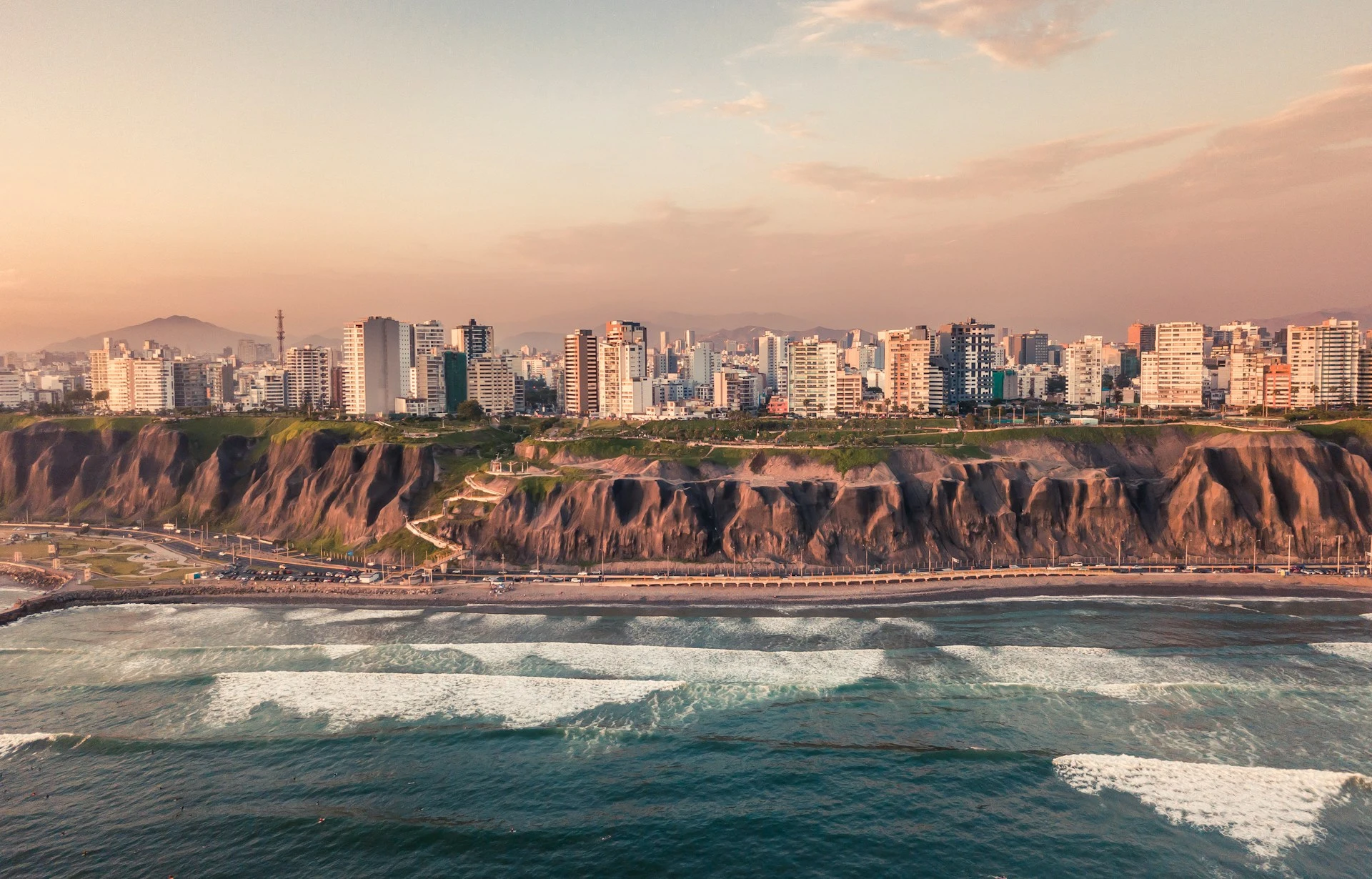We’ve already heard all about what it is to be a landscape architect. Now, let’s go all over the world to see some of the finest landscape architecture you will ever find.
Leave a comment below about which one you’ve added to your must-see bucket list! (I think I like #8 the most!)
#1. Thammasat University (Bangkok, Thailand)
With the largest urban rooftop farm in Asia, the Thammasat University Rooftop Farm, or TURF, was built in 2019. It is over 200,000 square feet in size, and it can grow approximately 135,000 rice meals per year due to how LANDPROCESS, the landscape and greenroof designer, constructed it. The rice strain is naturally-bred in order to be tolerant to floods and droughts, and cascading rooftops allow for runoff filtering and absorption. “Integrating landscape architecture with the ingenuity of traditional rice terraces,” Architizer writes, “TURF incorporates sustainable food production, renewable energy, organic waste, water management, and public space.” TURF revives the marshlands through biodiversity restoration and uses native plant strains to attract pollinators. Not only that, but the four retention ponds at the base are used to collect runoff in order for future use, all while functioning on solar energy. As if it couldn’t get any greener—in more ways than one—leftover food produced is composted and used as fertilizer.
#2. Xuhui Runway Park (Shanghai, China)
Designed by Sasaki and finished in April 2020, the Xuhui Runway Park is located on the former runway of the Longhua Airport, Shanghai’s only civilian airport until 1949. When the airport was decommissioned in 2011, Sasaki decided to repurpose the land. The park mimics a runway through the linear spaces for parking, cycling, and walking. Also, the layout promotes the use of public transit due to the limited and compact lanes. There’s a multipurpose lawn with a 3,500-person capacity, a sunken garden over the subway where events can be held for 900 people, and a birdwatching grove. All woodwork of viewing platforms is made of fused bamboo lumber, and rainwater treated in the rain garden and constructed wetland is to the quality requirements of the Surface Water Quality Standard of China. Finally, all of their water features—which are supplied with water from the on-site, treated stormwater—are aviation-themed, like the Runway Fountain, the Silver Wings Fountain, and the Children’s Interactive Fountain.
#3. Jewel at Changi Airport (Changi, Singapore)
From the genius of Safdie Architects, the Jewel is something to behold, and photos don’t do it justice. The Jewel connects the existing terminals at the Changi Airport and combines retail with plantlife. Based on the geometry of a torus (donut-shaped), the Jewel has five levels in total with an oculus at the center of its glass roof that showers water down through the levelled gardens. Also called “The Rain Vortex,” this rainshower is the world’s tallest indoor waterfall that becomes a light and sound show in the evenings. During Singapore’s frequent thunderstorms, rainwater flows at 10,000+ gallons per minute, allowing for significant collection of rainwater for reuse throughout the building. The Canopy Park on the 5th level contains attractions like suspended nets in the trees, a hedge maze, a suspended, glass-bottom bridge walk, and various horticulture displays. The interterminal train crosses through the gardens, and there’s an event space for 1,000 people. The Jewel understandably received international recognition and acclaim with the international architecture award from Chicago Athenaeum and The European Centre for Architecture Art Design and Urban Studies in 2016.
#4. TE ARA I WHITI (Auckland, New Zealand)
TE ARA I WHITI, translated to “The Lightpath,” is a hot-pink lightpath for cyclers in New Zealand, connecting them from Upper Queen Street to Victoria Street West. Formed from an unused part of a motorway off-ramp, the area has E-bikes and scooters available to rent nearby. LandLAB, the landscaping partner to Monk MacKenzie Architects for this project, said the design’s intent was “to create a hybrid space that supports its intended function as a cycle path but also enables exploration, discovery and occupation.” The path is actually part of a project by the Auckland Council, New Zealand Transport Agency, and Auckland Transport to make cycling safer and more convenient. The LED lights lining the safety barriers pulse when people pass them, and the western side has laser-cut designs along it. The entire trail starts off with a Māori design in the road’s surface, which pairs well with the color choice of hot pink that represents the wood of a tōtara tree, a species of podocarp tree native to New Zealand.
#5. “Pocket Patio” at 823 Congress Avenue (Austin, TX)
The “Pocket Patio” in Texas is our first stop in the US. The landscape architect dwg. had this to say about the project: “Challenging conceptions of existing street infrastructure, our initiative to convert parking spaces into dynamic seating and gathering areas for pedestrians has resulted in numerous transformations of public urban space in downtown Austin. These strategic interventions in the streetscape create a respite in the busy urban environment, shifting the focus from vehicular convenience to pedestrian experience.” Wausau Tile created twenty custom-molded unique pieces of concrete to form the abstract accent wall framing the patio. The abstract wall, also referred to as the “ribbon” wall, moves side-to-side and up-and-down, creating a different view from every angle and direction. The team used an air-spade to remove the concrete and parking spaces. Air-spades use compressed air to remove soil without harming tree roots as much as normal excavation would. With this method and some extra quality, uncompacted dirt, they were able to increase soil volume for the already-existing trees. Now the planting areas collect 40 times more stormwater than before!
#6. Scioto Greenways (Columbus, Ohio)
Adding onto a project already in motion in Ohio, MKSK used its landscape architectural skills to create 33 acres of new parkland and easy access to the river by decreasing the Scioto River’s width. (Just to put that in perspective, that is roughly 26 football fields!) To restore the natural flow of the Scioto River, MKSK removed the Main Street Dam. Now, the greenways connect the entire downtown riverfront from OSU to the Scioto Audubon Metro Park. Seven hundred and eighty-six new trees were planted, and “over 4500 mussels were rescued and relocated to friendlier waters, including 8 native species,” according to MKSK Studios.
#7. Ian Potter Children’s WILD PLAY Garden (Sydney, Australia)
Under the guide of ASPECT Studios, the Ian Potter Children’s WILD PLAY Garden’s mission was to create a counterpoint to children becoming isolated due to increased technology use. The play areas are arranged in stages that appear in a seemingly-endless manner. “By using a palette of natural play elements like sand, water, sticks, leaves, and mud—rather than prescriptive playground equipment,” ASPECT Studios said, “[we] produced a whimsical and immersive experience that encourages children and their imaginations to run wild.” The garden is named after Sir William Ian Potter, the Australian stockbroker and philanthropist who heavily contributed to business, the arts, science, and medicine. Additionally, the garden is a moment to educate children, as they play amongst experiences that feature references to the natural environment around them. A water feature in the garden even teaches children about the importance of conserving water as Australia is Earth’s second-driest continent (after Antarctica). “An artesian water basin brings life to the landscape through waterfalls, water jets, banks of mist and curtains of steam, that surprise and delight,” ASPECT Studios said, “while teaching in a tactile way the role water plays in creating and sustaining life.”
#8. Berczy Park (Toronto, Canada)
Berczy Park is located at the edge of St. Lawrence, the Old Town, and the Financial District, and it is broken up into three parts: a perennial garden for dogs, a plaza with a large fountain, and a green space for children to play. The main reason I’m adding this Claude Cormier et Associés-designed stop to my bucket list is that aforementioned fountain. The granite fountain in the center of the plaza is dog-themed to symbolize the increase in dog owners in the area.
It is a Victorian fountain with two tiers and has 27 life-size dog figures spouting water. Also, the perimeter of the basin has a trough for dogs to drink from, which is probably one of the cutest things I’ve seen. At the apex of this gorgeous fountain is every dog’s dream—and the apple of the dog statues’ eyes: a golden bone. And before the cat people come for me in the comments, there is a cat. It’s on the one side of the basin, and it stares at two birds on a lamppost across the plaza! (For those interested, the dogs included in the design are puppy versions of a Great Dane, St. Bernard, Dalmatian, Golden Retriever, and Boxer and adult versions of a Fox Terrier, Jack Russel Terrier, Beagle, St. Bernard, Bernese Mountain Dog, Dalmatian, Golden Retriever, Pug, West Highland Terrier, and Giant Schnauzer.) Besides the adorable fountain, the park was purposefully designed with diagonal pathways throughout to make the park feel bigger than it is. Also, the famous design on the back of the Flatiron Building has been embedded into the plaza’s design. There are American Elms, Oak trees, and Tulip trees that are all fed by runoff from a linear drain at the center of the park’s gradation.
#9. The Patio de los Naranjos (Córdoba, Spain)
This garden, aptly named the Garden of Oranges due to all the—you guessed it—orange trees planted there, is part of the Mezquita de Córdoba (the Great Mosque of Córdoba, which is now a cathedral). The orange trees replaced a lot of the originally planted trees in the 15th century, but there are still some palms, cypresses, and even an olive tree left there. Each tree is surrounded by a stone circle with a brick-lined irrigation channel from tree-to-tree in a rectangular pattern. The irrigation system is actually really neat. Runoff from the mosque’s roof is collected in a cistern under the patio. The water fills up in a rectangular pool that was once used for ablutions. The spigots off the sides allow water to flow down the channels and thus watering the trees. The name and appearance are credited to Bishop Francisco Reinoso.
#10. Ryōan-ji Temple Rock Garden (Kyoto, Japan)
The Ryōan-ji Temple has a lot of history. It was originally a villa of the Fujiwara family, an influential political figure, during the Heian Period. In 983, it became a memorial tomb for Emperor En’yū, and Hosokawa Katsumoto, a warlord of the Ashikaga Shogunate, transformed it into a Zen temple in 1450 with the help of a Myōshin-hi abbot named Giten Genshō, who became the temple’s founder. After the Ōnin War in 1467, Hosokawa’s son rebuilt the temple. Despite all of this history, no one is positively sure about who built the rock garden.
The temple is a UNESCO World Heritage Site and includes Kyōyōchi Pond, paintings in the Abbot’s Quarters, and Tsukubai Water Basin—a replica of the Zōroku-an basin outside the teahouse for those who don’t want to take part in the ceremonies. It is also the site of the “Seven Imperial Tombs,” mausoleums of Emperors En’yū, Ichijō, Go-Suzaku, Go-Reizei, Go-Sanjō, and Horikawa and Imperial Princess Teishi. As for the rock garden, it is a little over 2,600 square feet (248 square meters) of white sand with fifteen rocks spread out on it. The rocks are arranged so that at least one rock can’t be seen no matter what angle you look at it! The meaning of the rock arrangement is also unclear. Some think it looks like a tiger carrying her baby cubs over water, while others thing it spells out the Chinese character for “heart.” Fun fact: the gate on the east side of the rock garden is exclusively for imperial envoys but Queen Elizabeth used it when she visited in 1975!
While searching for these beautiful spaces, it was hard for me to narrow it down into two articles, so here is an honorable mention for you all!
Royal Kew Botanic Gardens (London, England)
Like the Ryōan-ji Temple, these gardens have a lot of history. The grounds were originally a summer home for Prince George and Princess Caroline of Wales with William Kent as their designer. After them, Augusta and Frederick of Wales continued on with the help of William Chambers along with Scottish gardener William Aiton. When Augusta died, King George III inherited the gardens, and he appointed Joseph Banks as the horticultural adviser. Together, they introduced roughly 7,000 new plant species in the gardens using seeds and plants from people who were sent to visit foreign countries. When Banks passed away, William Hooker became the adviser.
In 1781, the modern-day Kew Palace was called the “Dutch House,” and George III purchased it as a nursery for the royal children. With Hooker taking the helm, the gardens increased to 75 acres in size and the arboretum to 300 acres.
The Kew Botanic Gardens are, rightfully, a UNESCO Heritage Site, with UNESCO commenting that since its creation in 1759, “the gardens have made a significant and uninterrupted contribution to the study of plant diversity and economic botany.” The site has the world’s largest collection of living plants—with over 30,000 different types of plants!—and one of the largest herbariums in the world (over 7 million plant specimens). These aren’t the only records the gardens have broken however. The Palm House was the first large-scale structural use of wrought iron by Decimus Burton and Richard Turner, and the Temperate house is the largest Victorian glasshouse ever built!
Well that’s it for our first half of must-sees in the world of landscape architecture. Stay tuned for the second part coming soon! Again, don’t forget to comment your favorite one below!
Want to See More Landscape Architectural Masterpieces?
There is no doubt we’ve explored some of the world’s most impressive landscape architecture, blending innovation and sustainability to transform urban and natural spaces. From Bangkok’s rooftop farm to Sydney’s whimsical play garden, each spot highlights the creative magic of landscape design. Which one made it to your bucket list? Share in the comments and keep an eye out for part two of our must-see list!
Download the ALLMYNE app from the APPLE STORE or GOOGLE PLAY to seamlessly plan, capture, and share your travel journey with a global community of fellow explorers. Upgrade to our PRO subscriber level for even more perks, including audio recording in your journal, AI-powered location suggestions tailored to your interests, unlimited trip locations, and unlimited storage for all your travel memories. Download the ALLMYNE app now – the ultimate travel companion to enhance every step of your journey!
